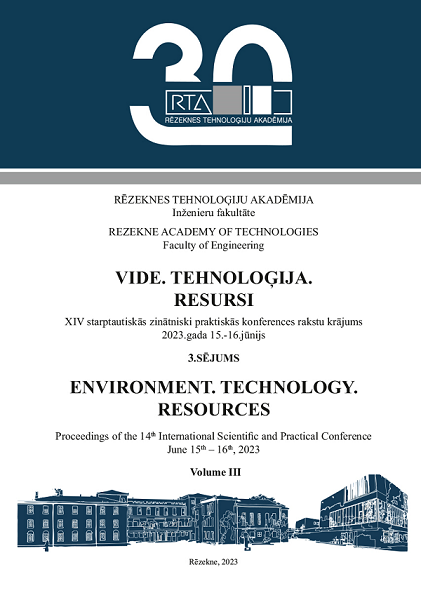WORKING REGIMES FOR FRICTION STIR PROCESSING OF ALUMINIUM ALLOY A6061
DOI:
https://doi.org/10.17770/etr2023vol3.7235Keywords:
aluminium alloys A6061, friction stir processing (FSP), friction stir welding (FSW), modellingAbstract
Friction Stir Processing (FSP) is a method for solid-state processing, in which a rotating tool is moved onto the material surface to modify the microstructure and thus obtain improved properties of the material surface. We study the effects of FSP on aluminium alloy A6061-T651 using a tool made at the Institute of Metal Science, Equipment, and Technologies with Centre for Hydro- and Aerodynamics (IMSETCHA) of the Bulgarian Academy of Sciences. The tool has a threaded pin with three flutes and a concave shoulder. Optimal process parameters should always be chosen for the treatment of new materials and when a new instrument is used in order to achieve target properties of processed zone. The appropriate properties, like strength, hardness, corrosion resistance, etc. require process parameters that are correctly configured. The most influential parameters on friction stir processing are direction of rotation of the tool, rotation speed, and traverse speed of the processing. In this paper, we investigate the properties of the processed zone for a total of 16 regimes: 4 rotation speeds (900, 1100, 1300, 1500 rpm) and 4 traverse speeds (15, 30, 45, 60 mm/min) using counterclockwise rotation, comparing the results with a previous study using clockwise rotation. Metallographic inquiry, hardness and tribological tests are used to estimate the stirred zone quality.
References
Z. Ma, “Friction Stir Processing Technology: A Review,” Metall. Mater. Trans. A, vol. 39, pp. 642-658, 2008.
H. Luo, T. Wu, P. Wang, F. Zhao, H. Wang, et al., “Numerical Simulation of Material Flow and Analysis of Welding Characteristics in Friction Stir Welding Process,” Metals., vol. 9, no. 6, p. 621, 2019.
M. S. S. El-Deeb, L. A. Khorshed, S. A. Abdallah, A. M. Gaafer, and T. S. Mahmoud, “Effect of Friction Stir Welding Process Parameters and Post-Weld Heat Treatment on the Corrosion Behaviour of AA6061-O Aluminum Alloys,” Egypt. J. Chem., vol. 62, no. 8, pp. 1367-1375, 2019.
R. S. Mishra, M. W. Mahoney, S. X. McFadden, N. A. Mara, and A. K. Mukherjee, “High strain rate superplasticity in a friction stir processed 7075 Al alloy,” Scr. Mater., vol. 42, no. 2, pp. 163-168, 1999.
K. Li, X. Liu, and Y. Zhao, “Research Status and Prospect of Friction Stir Processing Technology,” Coatings, vol. 9, no. 2, p. 129, 2019.
Howard Precision Metals Inc., “Applications of 6061 Aluminum Alloy.” [Online]. Available: https://www. howardprecision.com/applications-of-6061-aluminum-alloy/ [Accessed: Apr. 27, 2022].
H. W. Zhang, Z. Zhang, and J. T. Chen, “3D modeling of material flow in friction stir welding under different process parameters,” J. Mater. Process. Technol., vol. 183, no. 1, pp. 62-70, 2007.
N. D. Nam, L. T. Dai, M. Mathesh, M. Z. Bian, and V. T. H. Thu, “Role of friction stir welding – Traveling speed in enhancing the corrosion resistance of aluminium alloy,” Mater. Chem. Phys., vol. 173, pp. 7-11, 2016.
M. Selvaraj, V. Murali, and S. R. K. Rao, “Mechanism of Weld Formation during Friction Stir Welding of Aluminium Alloy,” Mater. Manuf. Process., vol. 28, no. 5, pp. 595-600, 2013.
J. S. Leon and V. Jayakumar, “Investigation of mechanical properties of aluminium 6061 alloy friction stir welding,” Am. J. Mech. Eng. Autom., vol. 1, no. 1, pp. 6-9, 2014.
S. Emamian, M. Awang, P. Hussai, B. Meyghani, and A. Zafar, “Influences of tool pin profile on the friction stir welding of AA6061,” ARPN J. Eng. Appl. Sci., vol. 11, no. 20, pp. 12258-12261, 2016.
K. K. Mugada and K. Adepu, “Effect of knurling shoulder design with polygonal pins on material flow and mechanical properties during friction stir welding of Al−Mg−Si alloy,” Trans. Nonferrous Met. Soc. China, vol. 29, no. 11, pp. 2281-2289, 2019.
V. S. Gadakh and A. Kumar, “Friction stir welding window for AA6061-T6 aluminium alloy,” Proc. Inst. Mech. Eng. Part B, vol. 228, no. 9, pp. 1172-1181, 2014.
A. Arora, A. De, and T. DebRoy, “Toward optimum friction stir welding tool shoulder diameter,” Scr. Mater., vol. 64, no. 1, pp. 9-12, 2011.
R. Nandan, G. G. Roy, T. J. Lienert, and T. Debroy, “Three-dimensional heat and material flow during friction stir welding of mild steel,” Acta Mater., vol. 55, no. 3, pp. 883-895, 2007.
R. Nandan, T. J. Lienert, and T. Debroy, “Toward reliable calculations of heat and plastic flow during friction stir welding of Ti-6Al-4V alloy,” Int. J. Mater. Res., vol. 99, no. 4, pp. 434-444, 2008.
A. M. Takhakh and H. H. Abdulla, “Improving the Mechanical Properties of Al7075-T651 Welded Joint Using Direct Friction Stir Processing,” in Proceedings of the The Second Conference of Post Graduate Researches (CPGR'2017), College of Engineering, Al-Nahrain Univ., Baghdad, Iraq, 2017, pp.6-10.
N. A. Patil, S. R. Pedapati, O. B. Mamat, and A. M. Hidayat Syah Lubis, “Effect of SiC/Fly Ash Reinforcement on Surface Properties of Aluminum 7075 Hybrid Composites,” Coatings, vol. 10, no. 6, p.541, 2020.
V. Sharma, Y. Gupta, B. V. M. Kumar, and U. Prakash, “Friction Stir Processing Strategies for Uniform Distribution of Reinforcement in a Surface Composite,” Mater. Manuf. Process., vol. 31, no. 10, pp. 1384-1392, 2016.
Ch. Kondoff, V. Dykova, R. Dimitrova, Y. Hadjitodorov, and R. Zaekova, “A Layer Formation on 6061 Aluminum Alloy after FSP,” Int. J. NDT Days, vol. 4, pp. 2603-4018, 2021.



